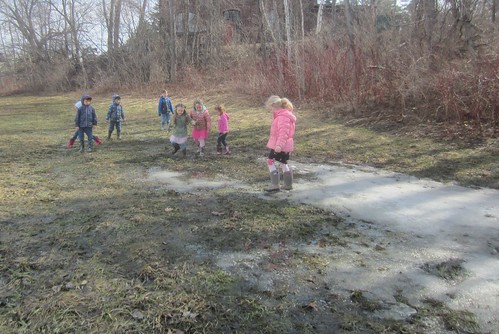Warm sunny days and rain melted away the last of the ice and snow, leaving spots of fun squishy mud. We hauled out all the riding, raking, and rolling toys and were very busy making good use of them. We spent as much time outside enjoying the warmth and sunshine as we could, including all of Wednesday and Friday afternoons.

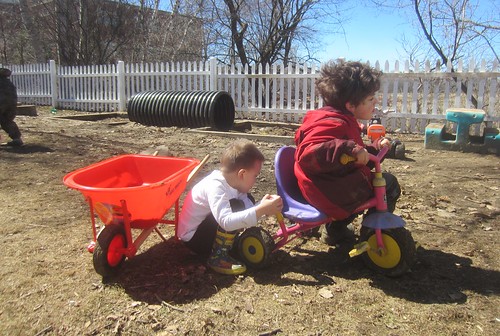

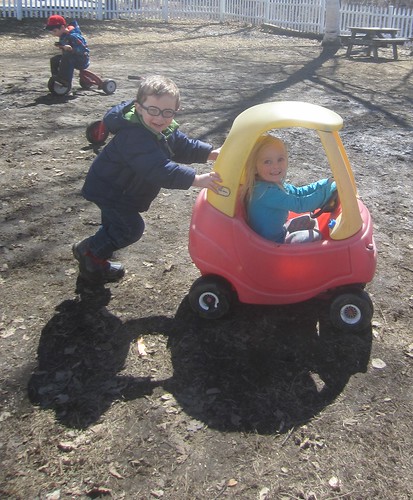
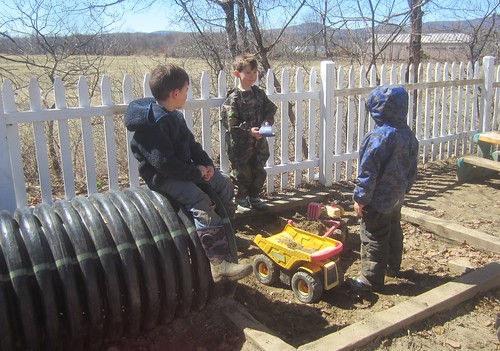

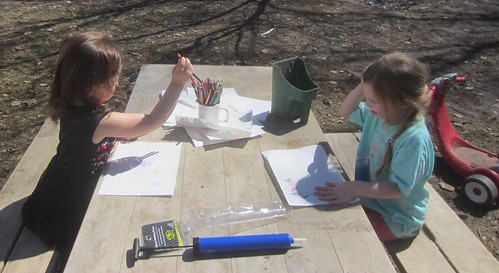
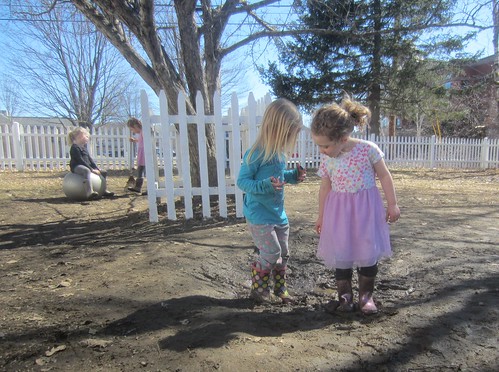

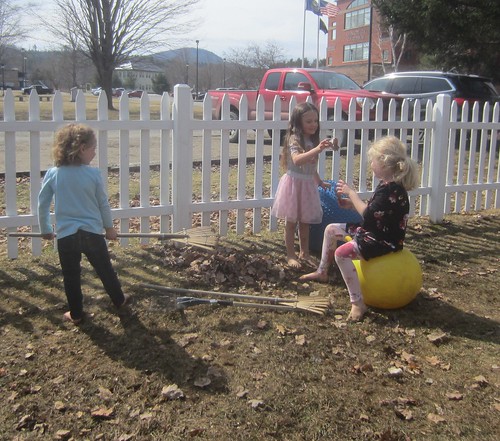
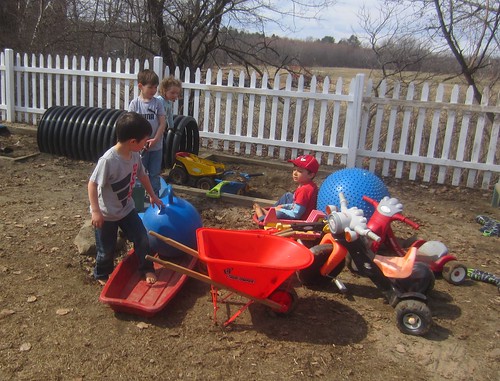 Monday students watched a video of artist Holton Rower creating a pour painting with cups of acrylic paint. As he poured each new color, it pushed the colors before it out, creating a ring of stripes. We were excited to make our own. We put our smocks on first, then selected a board for a base and a block to pour over. The children then selected colors they wanted to use and carefully poured them over their blocks, watching as the colors flowed and pushed out over the block.
Monday students watched a video of artist Holton Rower creating a pour painting with cups of acrylic paint. As he poured each new color, it pushed the colors before it out, creating a ring of stripes. We were excited to make our own. We put our smocks on first, then selected a board for a base and a block to pour over. The children then selected colors they wanted to use and carefully poured them over their blocks, watching as the colors flowed and pushed out over the block.


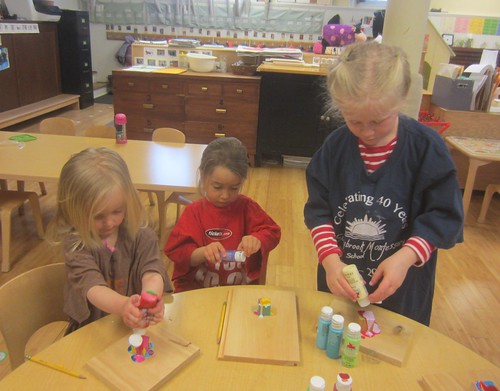
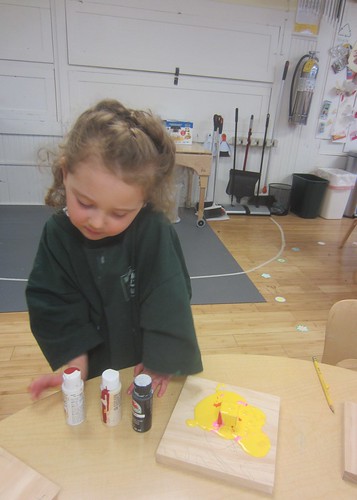


 Tuesday was hatching day and everyone was so excited to see the starting hole and watch the eggs rock as the chicks pecked and pushed. We were so excited to watch the eggs, anxiously waiting for them to emerge. We read a fun story called Big Chickens about some silly chickens that were scared of everything, until the end when they scared away the wolf, then they were no longer such chicken chickens. Midway through the story the first chick started to hatch out, so we all went over to the incubation area and found a spot where we could watch it come out of its’ shell. It was such an exciting experience! After watching it come out all wet and wobbly, we observed it for a while as it tried to get its’ balance and begin to dry, then we returned to group to set up the chick bin. Everyone had a turn to place a paper towel, pour some water into the waterer, and add a scoop of food to the feeder to prepare for the chicks. We continued to watch them throughout the day and saw as two other chicks began to peck a hole and rock and push on their shells, but no more hatched while we were at school. When we arrived on Wednesday morning, all four were out – two black, and two yellow. We set up the heat lamp, and watched as Alicia transferred them from the incubator to their new home, where they huddled under the heat. She showed them how to drink the water and eat the food, and by the end of the day, after many, many, naps, they were eating and drinking their food and water. The video of the chick hatching can be accessed by copying this link, or seen above: http://www.vimeo.com/phlumemedia/babychick.
Tuesday was hatching day and everyone was so excited to see the starting hole and watch the eggs rock as the chicks pecked and pushed. We were so excited to watch the eggs, anxiously waiting for them to emerge. We read a fun story called Big Chickens about some silly chickens that were scared of everything, until the end when they scared away the wolf, then they were no longer such chicken chickens. Midway through the story the first chick started to hatch out, so we all went over to the incubation area and found a spot where we could watch it come out of its’ shell. It was such an exciting experience! After watching it come out all wet and wobbly, we observed it for a while as it tried to get its’ balance and begin to dry, then we returned to group to set up the chick bin. Everyone had a turn to place a paper towel, pour some water into the waterer, and add a scoop of food to the feeder to prepare for the chicks. We continued to watch them throughout the day and saw as two other chicks began to peck a hole and rock and push on their shells, but no more hatched while we were at school. When we arrived on Wednesday morning, all four were out – two black, and two yellow. We set up the heat lamp, and watched as Alicia transferred them from the incubator to their new home, where they huddled under the heat. She showed them how to drink the water and eat the food, and by the end of the day, after many, many, naps, they were eating and drinking their food and water. The video of the chick hatching can be accessed by copying this link, or seen above: http://www.vimeo.com/phlumemedia/babychick.
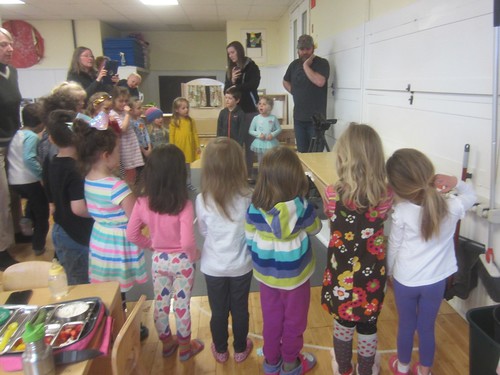



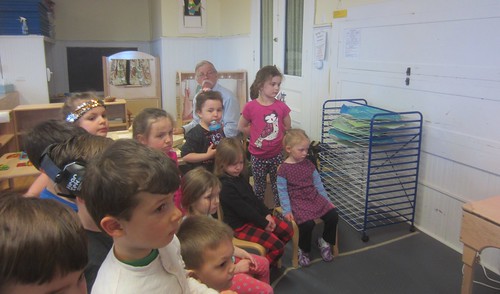
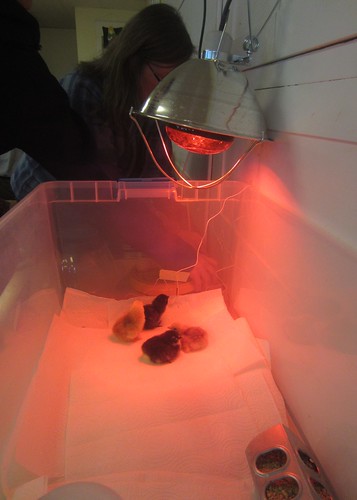

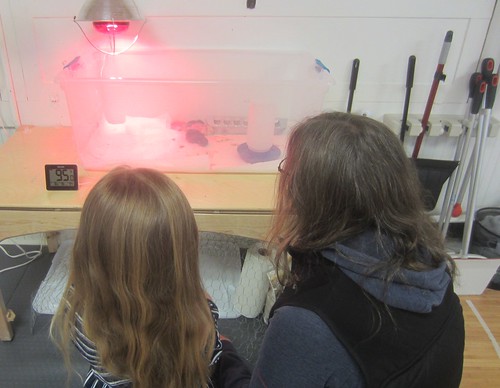
 As the saying goes, April showers bring May flowers, and lots of showers have been coming down and are predicted to soak us this weekend, so we began to talk about the water cycle. We learned the precipitation song, and read several stories about the water cycle, including The Wonder Thing, All the Water in the World, and Rivers of Sunlight: How the Sun Moves Water Around the World. We learned that all the water that is on the earth right now, is all the water that has ever been on the earth and was around in the time of the dinosaurs. We learned that dinosaurs drank the same water we drink today, and that it goes around, and around in a cycle, being moved by the sun. As it heats, it turns to vapor and evaporates. As it cools and collects around dust up in the atmosphere, it condenses and forms clouds. When the water droplets get too big, they come pouring down as precipitation in the form of rain, sleet, hail, or snow. This cycle continues over and over and over.
As the saying goes, April showers bring May flowers, and lots of showers have been coming down and are predicted to soak us this weekend, so we began to talk about the water cycle. We learned the precipitation song, and read several stories about the water cycle, including The Wonder Thing, All the Water in the World, and Rivers of Sunlight: How the Sun Moves Water Around the World. We learned that all the water that is on the earth right now, is all the water that has ever been on the earth and was around in the time of the dinosaurs. We learned that dinosaurs drank the same water we drink today, and that it goes around, and around in a cycle, being moved by the sun. As it heats, it turns to vapor and evaporates. As it cools and collects around dust up in the atmosphere, it condenses and forms clouds. When the water droplets get too big, they come pouring down as precipitation in the form of rain, sleet, hail, or snow. This cycle continues over and over and over.
We continued to discuss and read about courage and bravery. We learned that having courage/being brave, is not about NOT being scared, but doing things even when we feel scared, challenged, unfamiliar, or uncomfortable. A student practiced and practiced reading the story I Did It, then read it to the group on Tuesday morning. He shared an example of how he had to be brave when he learned to ride his bike, just like the main character in the story he read to us. We read the story Courage, and talked about the many examples shared in the book about different ways to be courageous, such as introducing yourself to a new group of people, riding your bike for the first time, and being brave in the dark. Another student shared how brave she had been the day before when she turned the water on and off in the sink for the very first time. When asked who was or is still afraid of the bathroom sink, many students raised their hands, as the knobs are super hard to turn and they often stick, and sometimes when they unstick it turns on very fast and gets very loud. This is frightening to many students, and has taken a lot of bravery to overcome. We shared examples of things that we are afraid of and how to be brave and conquer them. Another student shared how brave she is when she misses mom, and the mantra she says to herself that helps her feel better by reminding herself that mom loves her, misses her, and will be back soon. We also read the story Orion and the Dark, about a little boy named Orion who is afraid of lots of things, including balloons, storms, monsters, and most of all the dark. When the dark comes to visit and take him on adventures to all the darkest places, they become friends and he stops being afraid of the dark.
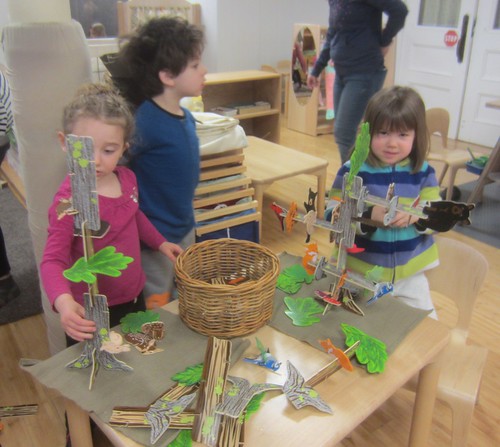


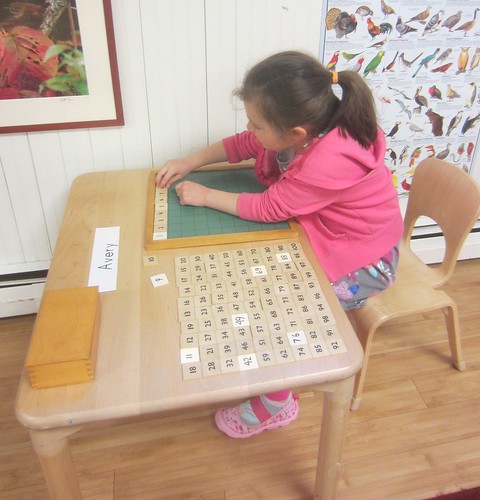
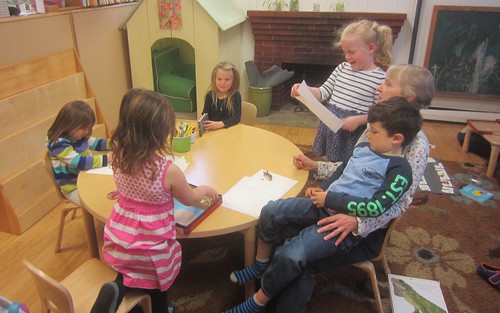

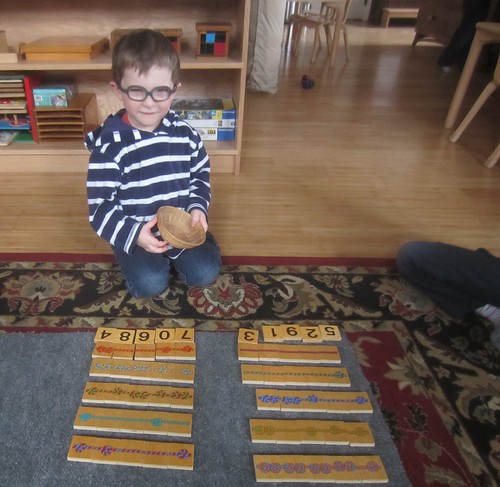


 The students had a lot of work to do on their bird houses with Mr. Bond, as we missed last week due to our walk around town. They added both the bottom and a side, screwing in a total of four screws – two for the student, and two for Mr. Bond.
The students had a lot of work to do on their bird houses with Mr. Bond, as we missed last week due to our walk around town. They added both the bottom and a side, screwing in a total of four screws – two for the student, and two for Mr. Bond.
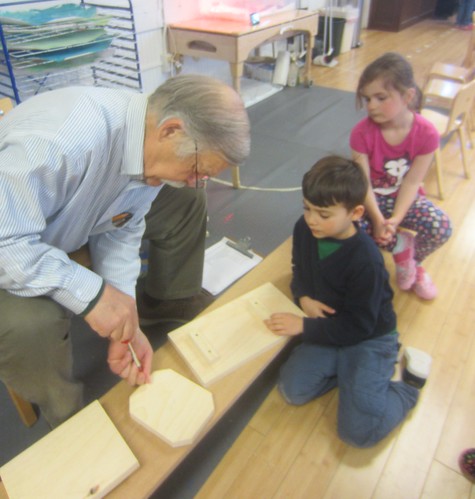

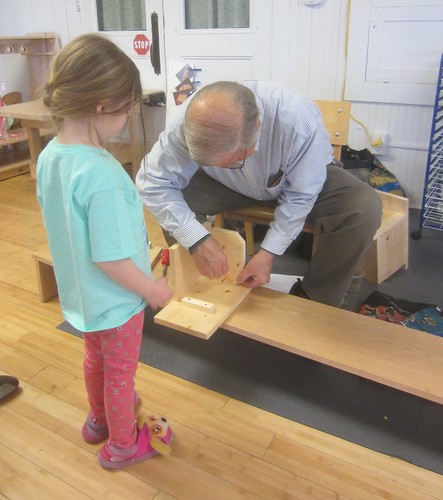 We have been singing train songs in preparation for our end of year presentation, when we will be acting out The Little Engine That Could. During music with Susan on Thursday she created a railroad track on the rug with tape. She played the penny whistle, and for each note she played she moved up or down the track according to whether the notes were higher or lower on the scale. Several children then took turns going up and down the track while listening to the pennywhistle to determine if the notes were higher or lower. Susan then introduced some instruments that make train sounds, including sandpaper blocks and tone blocks, which can be used for the chugga-chugga, chugga-chugga, chugga-chugga and a train whistle that goes chooo chooo! Some children played the instruments, and some children formed a train to move up and down the train track.
We have been singing train songs in preparation for our end of year presentation, when we will be acting out The Little Engine That Could. During music with Susan on Thursday she created a railroad track on the rug with tape. She played the penny whistle, and for each note she played she moved up or down the track according to whether the notes were higher or lower on the scale. Several children then took turns going up and down the track while listening to the pennywhistle to determine if the notes were higher or lower. Susan then introduced some instruments that make train sounds, including sandpaper blocks and tone blocks, which can be used for the chugga-chugga, chugga-chugga, chugga-chugga and a train whistle that goes chooo chooo! Some children played the instruments, and some children formed a train to move up and down the train track.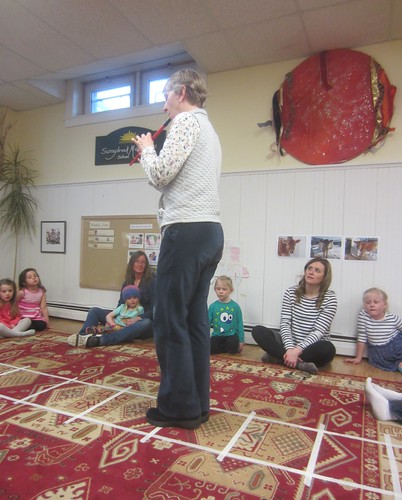

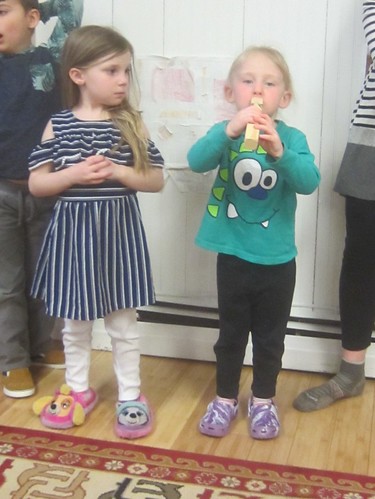
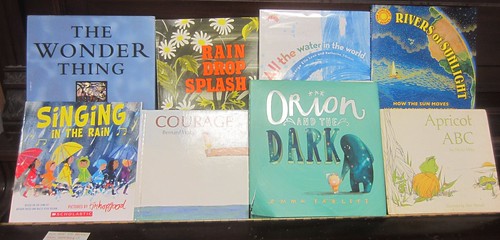 Friday students discussed signs of spring then took a long walk on the field behind school searching for signs of spring. They located many, including newly emerging clover, grass, and other small plants, buds on trees, puddles, and melting snow. We played “I Spy” and ran together in a group across the field to the item spied. Because it was such a beautiful, warm, sunny day, we spent the rest of the morning outside enjoying our day together before vacation.
Friday students discussed signs of spring then took a long walk on the field behind school searching for signs of spring. They located many, including newly emerging clover, grass, and other small plants, buds on trees, puddles, and melting snow. We played “I Spy” and ran together in a group across the field to the item spied. Because it was such a beautiful, warm, sunny day, we spent the rest of the morning outside enjoying our day together before vacation.
